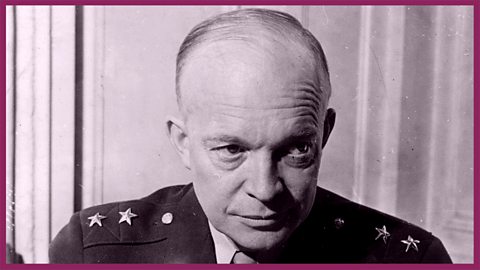Themes
D-Day 80th anniversary on 6 June, 2024 – knowledge of events 80 years ago; intergenerational respect – the sacrifices made by those involved in D-Day; collaboration – D-Day's success relied on the combined efforts of many nations; the impact of war and the need for remembrance, commemoration and learning.
Summary
D-Day, which took place on 6 June, 1944, was a pivotal Allied invasion during World War Two, marking the start of the liberation of Western Europe from Nazi occupation. Over 150,000 troops from the United States, Britain, Canada, and other nations landed on five beaches in Normandy, France, facing intense German resistance. The operation, codenamed Operation Overlord, involved extensive planning, deception tactics (the Germans were misled into thinking the Allies would attack further east, near Calais), and airborne assaults. Despite heavy casualties, D-Day was a crucial success, leading to the eventual defeat of Nazi Germany.
Resources
The assembly framework to download/print (PDF, 350KB); a map showing the location of the landings on the Normandy beaches; an archive BBC News clip with war correspondent Robin Duff reporting from the beaches of Normandy.
Videos
Emphasise that these are actual words spoken by men who took part in D-Day using preserved audio recordings of those who experienced the invasion first-hand. This archive material has been brought to life by a cast of young actors lip-syncing in documentary settings, combined with archival footage and immersive documentary-style recreation. The two videos feature interviews from both a British and German perspective to provide an understanding of the actions of the human beings involved on both sides – the sacrifices made, the impact of war and the need for remembrance, commemoration, and learning.
The videos are taken from the BBC Two series D-Day: The Unheard Tapes, available now on iPlayer. This innovative three-part documentary has been produced in partnership with Imperial War Museums, The Open University and The National WW2 Museum, New Orleans.
Video 1: British troops
This clip features a dramatised reconstruction of troops engaged in combat on the Normandy beaches. It includes a scene where a soldier sustains a gunshot wound to the shoulder, resulting in visible blood loss from the injury. Teacher review is recommended prior to use in class.
Kate Vigurs
Another wave of British were about to land on the eastern boundary of the D Day beaches known as Sword Beach.
James Kelly
When we got there it was just a shambles. I was one of the first three men out and you had to crouch on the deck then. And I saw a thing going on, on the beach.
And I thought, 'ah, how are we gonna get through that…?'
Kate Vigurs
Unknown to James, the first wave at Sword Beach had already suffered terrible casualties. And this is what would have confronted him as he approached the beach. And when the commandos came on behind them some of them described it as being like a sea of khaki that was laid out in front of them, due to the sheer number of casualties lying in the sand.
James Kelly
Our job was to get off the beach, as fast as you can. That was the instructions that we were given.
Peter Lieb
The German fortifications at Sword Beach were quite strong. You had minefields, you had heavy weapons, you had concealed machine gun positions in the houses. So, the British forces there had to overcome a lot of challenges to break through the Atlantic Wall.
Warwick Nield-Siddall
As far as were concerned, to us young lads, it was an adventure. This was it, you know.
James Kelly
There was another chap, a fella named Charlie Hall, who came with me. I was a Bren gunner then and Charlie was my number two, Charlie Hall. They liked you to have your mate because the two of you would work much better, you know, you would fight better. You would always have the company and the friendship of another person with you. When were at the beach, there was only one thing in my mind - it was to get up. Captain Powell was in charge, he was leading, followed by me, followed by Charlie Hall. All I remember is a blinding flash my friend Charlie Hall was down on the deck, he was bleeding and the blood was pumping out of his neck, and right out of his Combined Ops badge that was on his shoulder and the blood was pouring out, it was pumping out from both places. I'd only just knelt down and it was only a matter of turning to him and saying, 'Come on Charlie, come on'. And this voice said, 'Get going, get going! You're not supposed to stop! Get going.' So I went. I just left.
James Bulgin
For those men landing at Sword,the first challenge is to get off the beach itself, young men like James and Warwick, they were totally vulnerable. Behind them is the English Channel, so they can't go backwards. The only way to survive here is to do what must have seemed to be the most counter intuitive thing, which is to run towards the fire coming from the gun positions above the beach.
Warwick Nield-Siddall
I had two young Marines as a single unit. We got ashore, one of them got killed incidentally. And we got on the beach, which was covered in bodies, tanks and smoke…
Video 1 summary
This short film features interviews with two British (Royal Marine) commandos, who landed on Sword Beach in the second assault wave at 08:45am. Historians provide details of the minefields and other challenges faced by the Allied troops and how the commandos encountered a 'sea of khaki laid out in front of them' – describing the casualties from the earlier assault wave in their green uniforms.
PLEASE NOTE: This short film contains scenes which some viewers may find upsetting. Teacher review is recommended prior to use in class.
The duration is 4min48sec and the final words are: 'We got on the beach, which was covered in bodies, and tanks, and smoke.'
Video 2: German troops
This clip features an original audio interview recounting the death of a soldier following the detonation of a grenade inside a bunker. A dramatised reconstruction of the aftermath shows a lifeless body lying on the floor. Teacher review is recommended prior to use in class.
Raimund Steiner
(Translated from German speech) As an officer, I had to be responsible for my people and I took that very seriously. That's my upbringing.
Peter Lieb
Hammond was an interesting character because he was politically an opponent to the Nazis, but still he's an officer serving for the Germans, knowing that this is probably not the right. cause he's fighting for, but still he felt a loyalty towards his men.
Raimund Steiner
(Translated from German speech) Before the nazis arrived in… invaded Austria, my father and the future Nazi regional official, they were always quarreling because my father said that Hitler is a criminal, that there will be a war. And it wasn't long before my father found himself in Dachau. Dachau Concentration Camp. And by the time he came out, I'd already been drafted into the military. One day in my observation point, this young orderly of mine suddenly started singing songs, melancholy ones and then the tears came. And I said, "Arnold, what's the matter?" As if he was a boy. And he said, "I have such nice parents." "And a sister who I love so much." And I said, "Yes, you'll see them again." And he said, "I have a kind of feeling that I won't see them anymore." And then I said, "Arnold, you know what?" "You stay here today." "Go into the bunker and don't let yourself be seen." "Clear up for today, you're safe there" "And tonight we'll pick you up." At night, I called him, there was only a telephone connection. (Telephone rings) No Arnold. (Telephone rings) I went into Arnold's bunker anyway. It had an eye slit and he had looked out. At that moment, a grenade must have come right through the slit. It tore at my heart. I was in tears. Then I sat down and wrote to his parents. That was my hardest letter.
Video 2 summary
This short fim contains an interview with a German commander, who recounts his father being sent to Dachau (concentration camp) for opposing Hitler and he himself is described as politically opposed to the Nazi regime. He tells the story of a young soldier under his command, who is killed during the battle – the scenes are dramatised with his original narration.
PLEASE NOTE: This short film contains scenes which some viewers may find upsetting. Teacher review is recommended prior to use in class.
The duration is 3min26sec and the final words are: 'Then I sat down and wrote to his parents - that was my hardest letter…'
Key links
Assembly framework (PDF, 350KB) document
Download / print the assembly framework ready for use
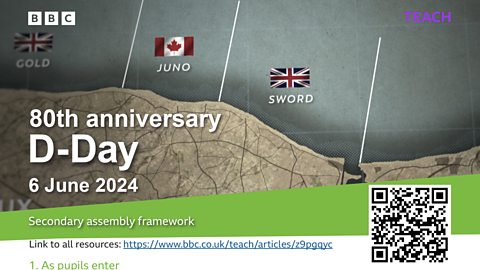
The Allied invasion landed on the beaches of Normandy on the northern coast of France. image
Click to display the image full-size
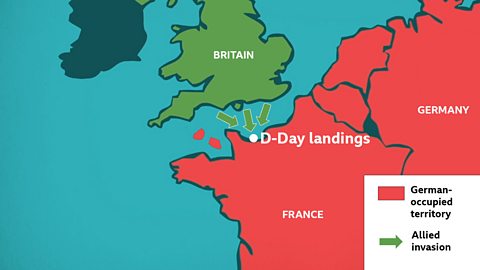
War correspondent Robin Duff describes troops landing by parachute in Normandy on D-Day.
The paratroops are landing…they're landing all round me as I speak…they've come in from the sea and they're fluttering down…and they're just about the best thing that we've seen for a good many hours. They're showering in…there's no other word for it.
Assembly framework
1. Entry
Play the archive BBC News clip with war correspondent Robin Duff reporting from the beaches of Normandy. Alternative options can be found here with actors Benedict Cumberbatch, Patrick Stewart and Toby Jones recreating D-Day news reports for the 70th anniversary 10 years ago.
2. Introduction
Explain the background to the D-Day landings:
When? 6th June 2024 is the 80th anniversary of D-Day, the start of the Normandy Landings 1944. This assembly should be scheduled close to D-Day.
Why is it called ‘D-Day’? This is a generic term referring to the first day of any military operation – so there would have been many other ‘D-Days’ in World War Two. D-Day emphasises the importance of the Day – in other words it is the day.
What happened? D-Day was the first day of Operation Neptune, a naval assault on the Normandy beaches and was part of the larger Operation Overlord – the largest sea and airborne invasion in history, with more than 150,000 troops, over 6,000 ships and more than 10,000 aircraft attacking the German occupation on the northern French coast. The successful attack was a turning point in the war and gave the Allies a foothold in Western Europe by shattering Hitler’s defences – the concrete barriers, bunkers and gun emplacements known as the Atlantic Wall.
Who was involved? International collaboration was crucial to the allied victory. While most of the personnel that landed in Normandy on D-Day were from the UK, the United States, and Canada, a significant number from Australia, Belgium, Czechoslovakia, Denmark, France, Greece, the Netherlands, New Zealand, Norway, and Poland also took part in the Normandy Campaign.
Where? The Allied invasion landed on the beaches of Normandy on the northern coast of France.
3. Videos
Emphasise that these are actual words spoken by men who took part in D-Day using preserved audio recordings of those who experienced the invasion first-hand. This archive material has been given new life by a cast of young actors lip-syncing in documentary settings, combined with archival footage and immersive documentary-style recreation. The two videos feature interviews from both a British and German perspective to provide an understanding of the actions of the human beings involved on both sides – the sacrifices made, the impact of war and the need for remembrance, commemoration, and learning.
4. Opportunity for discussion
You could ask students to talk to those sitting next to them about how the videos shape their view of those who died, or of the veterans who took part – perhaps asking them to summarise it in three words.
5. Opportunity for reflection
You may wish to consider the pivotal significance of D-Day – it enabled the Allies to win the war. It may be beneficial to relate to the students that many of the troops were teenagers, not much older than those in the assembly, with many of them being injured or killed on the beaches – it is important to remember the sacrifices they made.
Related links
WW2 Clips. 'D-Day has come' audio
The BBC announces that 'D-Day has come' on 6 June 1944.
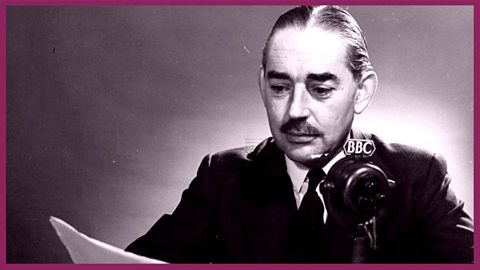
WW2 Clips. D-Day report. audio
A BBC reporter describes paratroops landing in Normandy on D-Day.
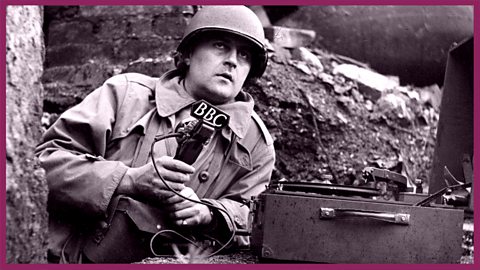
WW2 Clips. Eisenhower speech after D-Day. audio
General Dwight D Eisenhower broadcasts to the people of Western Europe in a statement prepared for D-Day.
